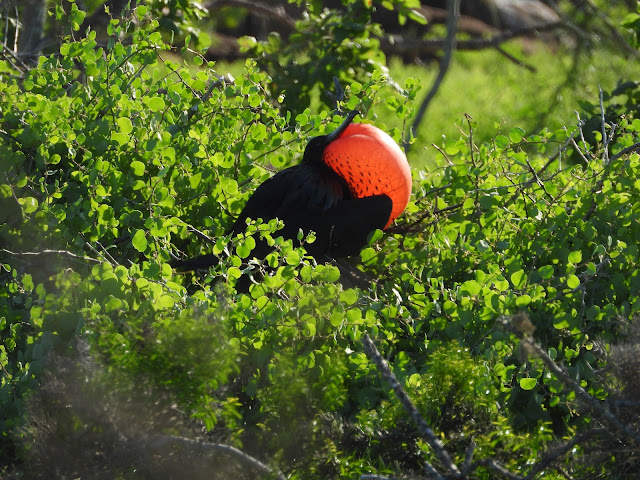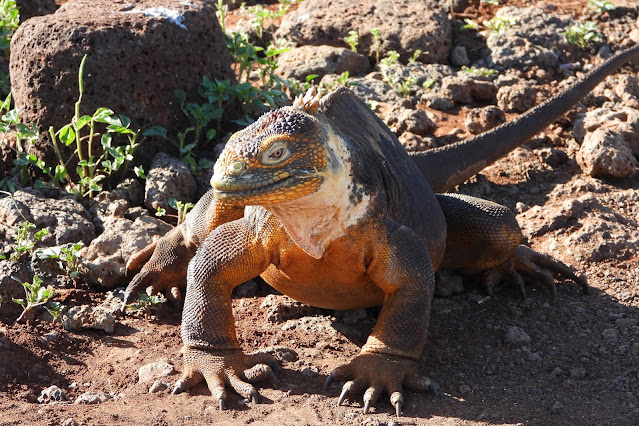After lunch and some orientation we were off to our first major adventure, a hike on North Seymour Island.
Lots of rules to protect this unique place. Over 97% of the land mass of the Galapagos Islands is part of the Galapagos National Park, established in 1959. That is not to mention it has been a World Heritage Site since the beginning of the World Heritage program in 1978. Based on controls established by Ecuador in 1990, the Galapagos Islands are among the most highly-controlled ecosystems in the world.
For example, all vessels operating in the islands must be registered and pre-approvedl The largest cruise vessels allowed in the islands can carry a maximum of 100 passengers, but most are considerably smaller. All crew members must be Galapagos residents or have special work permits. All visits to the park are scheduled in advance. Areas that might be impacted by frequent visitors are only visited infrequently. Some areas of the islands are completely off limits.
From a tourist's point of view there are fourteen rules anyone visiting the islands must follow. Most are pretty straight forward or did not apply to us, but some were of interest.
- Visitors to any protected areas must be accompanied by an authorized naturalist guide. These guides are very knowledgeable, having gone through extensive training. It is actually very difficult to become an authorized naturalist guide. Cruises are required to have a guide for every 16 guests, hence the reason for many small 16 passenger vessels in the Galapagos. The La Pinta had four naturalists on board. This made for a great visitor to guide ratio, since we only had 41 guests on board.
- We had to remain on marked trails at all times. Staying on the trails was usually not a problem, except when iguanas or boobies decided to take over the trail.. Most of the native animals have never had mammalian predators so they have no inherent fear of humans. It was not uncommon for animals to be in the middle of the trail and they were totally oblivious to us even if we came quite close. When that happened, the next rule took precedence.
- Visitors must remain at least six feet from wildlife. Even that was sometimes a problem, especially when sea lion pups or mockingbirds were involved, but those are stories for later posts.
Despite my comments above about restrictions to the number of visitors, North Seymour Island is one of the most visited sites on the islands. It is very close to Baltra and even day trip boats from Santa Cruz Island can get there easily. Despite some other boats anchored off shore, I don't think I saw anyone from another ship on land while we were there.
Landing on North Seymour. All trips to land anywhere in the islands from the ship are via panga. There are two types of landings, wet and dry. This was a dry landing, so we wore our hiking boots, but dry landing does not mean pulling up to a dock. The guidebook that I had bought ahead of time (but did not read for this location) describes the landing on North Seymour as follows:
The dry landing on black basaltic lava can be slippery, and is quite a test for the panga driver. After a short climb over the 'pillow lavas' formed by quick cooling underwater, the rest of the trail is flat and easy, apart from some boulders on the frigate bird loop.
I think the landing would have been very slippery, but the guides covered the rock with a soaking wet towel which helped tremendously. The panga was bobbing up and down in the waves but the driver was gunning the engine so at least it kept the panga up against the rocks, Off the bobbing panga we went, then we scrambled up the very large lava "steps".
 |
| This was also taken through our cabin window. It shows how vertical the edge of the island is. For reference this ship, the Koln, is a 104 foot luxury 16 passenger expedition yacht. |
Once on top, the island was fairly flat, although covered with lots of boulders. Like Baltra it was formed from submarine lava uplift but is much smaller than Baltra, only about 0.73 square miles. We went counter clockwise around the approximately 1 mile long loop trail on the southwest corner of the island.
 |
| Aerial photo with the GPS track of our hike on North Seymour Island. The entire loop is about a mile. |
Frigatebirds. We immediately encountered lots of birds everywhere. We were in the midst of a huge colony of frigatebirds. There are two different frigatebirds in Galapagos, the Magnificent Frigatebird and the Great Frigatebird. The guide indicated they both had nests in this colony. Although somewhat different in size they are both huge, on the order of 3 feet tall with a wingspan of over 7 feet.
Some were in the scrubby trees.
 |
| Several male and at least one female frigatebird |
Many many were flying everywhere.
 |
| A male frigatebird flies overhead |
Their huge size was made really apparent when one of them decided to make a low pass over us.
 |
| Look out, James!! |
One of the things we really had hoped to see while in Galapagos were male frigatebirds with their expanded red gulac sacs, part of their ritual to attract females. One source I had read ahead of time indicated they didn't usually show that behavior until June. Well, the frigatebirds were early this year. Their huge red gulac sacs, which looked like red beach balls from a distance, were readily apparent on our walk.
 |
| The inflated red sac really stood out in the sun even from a distance |
 |
| Male above, female below with a chick |
 |
| The male is watching the sky for a prospective female to fly over. When one did, he went wild making all kinds of noise. |
Lots of land iguanas. We couldn't spend all of our time looking for birds in the air, because we also quickly encountered land iguanas, usually right where we would likely step on them.
 |
| A land iguana on the trail |
They looked very scary. They can be 5 feet long and weigh 25 pounds.
 |
| Land iguana with very long claws |
However, they are mostly herbivores and didn't seem to care about us.
 |
| A land iguana munching on some plants |
We also saw several types of gulls, ground lizards, sea lions, and what turned out to be the first of thousands of Sally Lightfoot Crabs.
 |
| Sally Lightfoot Crab |
All of these things were exciting, but it was the blue-footed boobies that stole the show.
Booby Nests. There were many boobies along the trail sitting on nests. At least one had a new chick not more than a day old.
 |
| A blue-footed booby on a nest with a newly hatched chick. |
 |
| Newly hatched blue footed booby with at least two additional eggs |
When we got to the beach we had to detour off the marked trail to go around this booby. Booby nests are traditionally small depressions in the soil or sand, but any depression here was minimal.
 |
| Blue-footed boby on her "nest" |
 |
| Blue-footed booby with an egg under her left foot |
Booby dance. The real treat was getting to see a booby mating dance. Like the inflated gulac sacs of the frigatebirds, booby mating dances are not common until June. However, at least one booby couple put on a bit of a show for us.
 |
| Watching the booby dance. The boobies (actually two couples here) are in the center. The island Daphne Major is in the distance. |
Blue feet are very important to blue footed boobies. Only very healthy birds have dark blue colored feet. Females are attracted to males with the best looking blue feet. With that in mind, the males show off their feet to a prospective lady friend by doing exaggerated strutting.
 |
| A male showing off his blue feet |
He may also climb on a rock to look taller.
 |
| A male showing off his feet, but now up on a nearby rock. |
He will also give small gifts to the female, such as a stick. I am not sure why a stick is important since they don't build nests, but I guess there aren't a lot of other easily available potential gifts.
 |
| The male offers a stick to the female |
By this time all was going great. The female was showing her interest by dancing along with the male.
 |
| The male and the female both showing off their feet by strutting together |
Unfortunately just about that time a second couple showed up and seemed to be claiming the territory. There was general disagreement and I am not sure that the controversy got resolved. However it was great to see these birds and how they interacted. Although we were not that close, they didn't seem bothered by us in the least.
 |
| Two couples appeared to be one couple too many |
As usual, I got so engrossed in watching what was going on and taking pictures that I forgot to take a video. I did think to make a short one. Turn on the sound so that you can hear the bird sounds and the guide's explanation.
All in all, it seems that everyone had a great time on North Seymour Island. However, it was getting late. On the equator the days are 12 hours long, roughly 6 am to 6 pm. What was surprising to me was how quickly it got dark. We needed to be back on the ship before it got dark, so we made our way back to the panga boarding location, somehow got down the very large lava steps and boarded the panga for the short trip back to the boat.
.jpg) |
| Gwen and Paul with a friend |
Towel Creatures. There was yet one more surprise that awaited us. Our cabin steward had left delightful towel characters on our beds.
 |
| Towel creatures by our cabin steward |
It turns out he left different characters every day. It was so much fun, made even better by the fact that he was always hanging around when we returned to the ship to see our reaction. It pushed my scant knowledge of Spanish to the limit, but I was able to find out from him that it took him about 10 minutes to make them. It had taken 8 months for him to learn how to do make them in the first place.
There was still happy hour, a lecture and a world class dinner to go, but it had been a wonderful first day on the La Pinta.



No comments:
Post a Comment